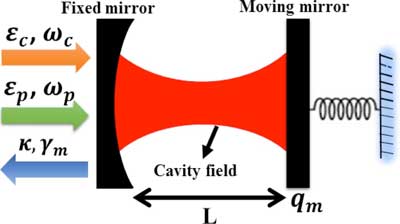| Oct 16, 2020 |
Slowing light in an optical cavity with mechanical resonators and mirrors
(Nanowerk News) Theoretical physicists Kamran Ullah and Hameed Ullah have shown how a position-dependent mass optomechanical system involving a cavity between two mirrors, one attached to a resonator, can enhance induced transparency and reduce the speed of light.
|
|
We are all taught at high school that the speed of light through a vacuum is about 300 000 km/s, which means that a beam from Earth takes about 2.5 seconds to reach the Moon. It naturally moves more slowly through transparent objects, however, and scientists have found ways to slow it dramatically.
|
|
Optomechanics, or the interaction of electromagnetic radiation with mechanical systems, is a relatively new and effective way of approaching this.
|
|
Theoretical physicists Kamran Ullah from Quaid-i-Azam University, Islamabad, Pakistan and Hameed Ullah from the Institute of Physics, Porto Alegre, Brazil have now demonstrated how light is slowed in a position-based mass optomechanical system.
|
 |
| A schematic diagram of the position-dependent mass optomechanical system studied in this work. (Image: K Ullah and H Ullah)
|
|
This work has been published in EPJ D ("Enhanced optomechanically induced transparency and slow/fast light in a position-dependent mass optomechanics").
|
|
Ullah and Ullah describe cavity optomechanics, which involves optical modes set up in a cavity between mirrors. The cavity mode, which is driven by a strong field and probed by a weak field, provides a ‘playground’ for investigating phenomena including slow light and optomechanically induced transparency (OMIT). The latter is a quantum effect in which the optical response of atoms and molecules is controlled by an electromagnetic field.
|
|
In this work, the physicists studied a cavity system comprising a fixed mirror and a movable one. The moving mirror oscillates along the axis of the cavity with a single harmonic frequency. By considering the total mass of the resonator as dependent on its position, and calculating the effective Hamiltonian of the whole system (which describes its total energy), Ullah and Ullah showed how the system can enhance OMIT and slow light.
|
|
As the mass is position-dependent, the system is non-linear and the nature and magnitude of the quantum effects observed depend strongly on the value of a non-linear parameter, alpha.
|
|
And this work is not entirely abstruse. OMIT and slow light already have important applications in quantum information processing, optical switches and optical sensing, and these technologies can only become more useful as quantum computing moves out of the lab into the workaday world.
|

